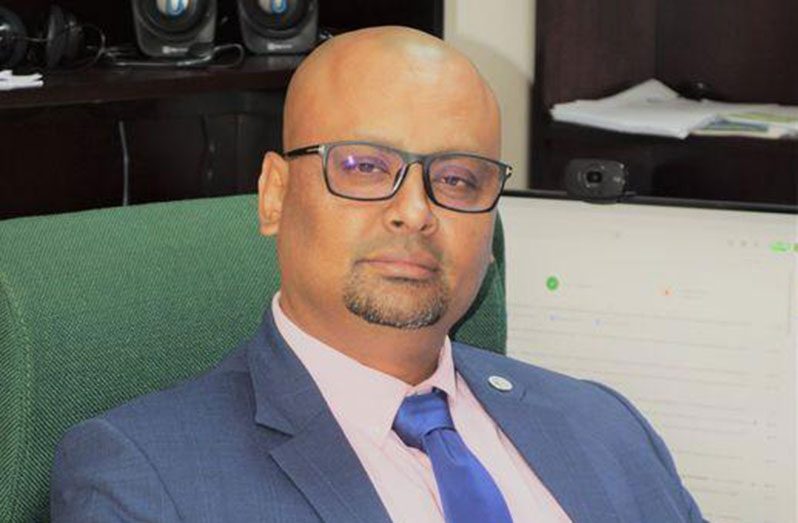By Feona Morrison
GUYANA has made significant strides in strengthening its oil permits as well as environmental laws and regulations, drawing from the experiences of other countries and international standards and guidelines, according to Kemraj Parsram, Head of the Environmental Protection Agency (EPA).
Various permits have been granted to ExxonMobil (Guyana) for its oil operations in the Stabroek Block. In his recent appearance on the Energy Perspectives Podcast, Parsram underscored the nation’s swift progress in this industry, placing strong emphasis on the crucial need to glean insights from international exemplars.
He provided a detailed account of the significant advancements made in the energy sector’s permitting process, ensuring that Guyana will be absolved of any liability in the event of an oil spill.
“Our first oil and gas permit was in 2017. At that time, we were newbies in the oil and gas sector. And the EPA never had to deal with oil and gas. We were dealing with forestry and mining. But we managed to quickly come up with permit conditions guided by what existed at that time…like the IFC [International Finance Corporation] Standards and Guidelines…and came up with a permit.
“But that was the baby of the permits. We are now four or five years into it and we have indeed grown leaps and bounds. And the key message here is that we are learning and we are learning fast in order to make those changes to improve our permit,” he explained.
He said the nation’s oil permits have undergone a rigorous strengthening process in order to properly manage the environmental and economic impacts.
The strategy of Guyana involves the clarification of permissible aspects of flaring.
“Because there was zero routine flaring from day one. But then we realised that there are situations that would require some amount of flaring. We just can’t say no. Because for safety reasons, you have an emergency; you may have to flare. So, we strengthened those guidelines, we strengthened the language and as well attached a fee or tax in a case where they are flaring in excess of what is allowed…,” the EPA Director explained.
In the event of flaring exceeding designated timeframes, the company is obligated to compensate for the emission of Carbon Dioxide equivalent (CO2e) at a rate of US$50 per tonne of CO2e.
Parsram also discussed financial assurance which he described as a “big thing”. He said the Environmental Protection Act is very clear about “full liability” in the event there is an oil spill. “In the words of the Act, it is strict liability…It means if you’re a permit holder you are fully responsible and [have] fully liability for any pollution that you cause. And that doesn’t have to be proven.”
But how does this transfer to securitisation of liability?
He explained: “What we have done over the past two, three years…we looked at what our Act says about financial assurance and strengthened those requirements. Looking at how it exists in other jurisdictions. Other jurisdictions indeed have similar laws. You have full liability; you have strict liability. But securitisation is a different story…”

Parsram added: “We looked at NOPSEMA in Australia, we looked at the UK, we looked at the USA and Canada and we put in key measures because our Act says that financial assurance has to be at an amount. How do I come up with that amount? I just can’t pull it out of rabbit’s ear or out of a hat.” NOPSEMA is Australia’s independent expert regulator for health and safety.
According to him, an estimate of the realistic and credible costs of an oil spill must be conducted in accordance with NOPSEMA criteria. “And so, we have done that. We have an initial value and we have put in place a parent company guarantee. And that is only in the event if the permit holder defaults. One of the key things we also asked for is an annual declaration of their liquidity or their financial statements or the balance sheet at the end of the year to show us that you [the company] have enough money to cover your liabilities,” he said.
“And it’s US$2 billion initially. It will not decrease; it’s the floor. And with increasing risks and increasing developments, that estimate can go up.”
The required US$2 billion oil spill guarantee has already been handed over to the EPA by Stabroek Block operator ExxonMobil and its co-venturers, CNOOC and Hess.
Capping stack
Parsram provided an explanation that the granted permit pertains to spill prevention and necessitates the presence of a capping stack—a subsea mechanical barrier designed to effectively shut in and redirect uncontrolled flow. As per his remarks, the development of this was prompted by the oil spill that took place on April 20, 2010, in the Gulf of Mexico off the coast of the United States, specifically at the BP-operated Macondo Prospect.
Furthermore, he stated that this technology can be promptly deployed over the blowout preventer to effectively impede any further flow. “As part of our permit, we also require inspecting of the blowout preventer to make sure that it is up-to-date and can do what it is supposed to do,” Parsram pointed out.
In accordance with his account, the EPA has directed the operator to have the capping stack within the country, and it is expected to arrive soon to facilitate swift deployment if the need arises.
He noted that this is the first time this type of technology will be available in the region.
Under the revised permits, Parsram said that ExxonMobil is now required to periodically monitor the effects its operations are having on water quality, sediments and biodiversity.
This, he emphasised, is a key achievement the EPA is proud of. The EPA Head said that Guyana’s Environmental Protection Act and regulatory frameworks are “very comprehensive”. “It is probably one of the best pieces of legislation in this region. That I’m sure about,” he declared.





.jpg)








